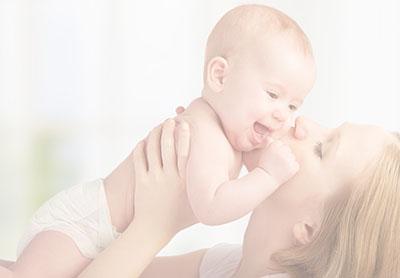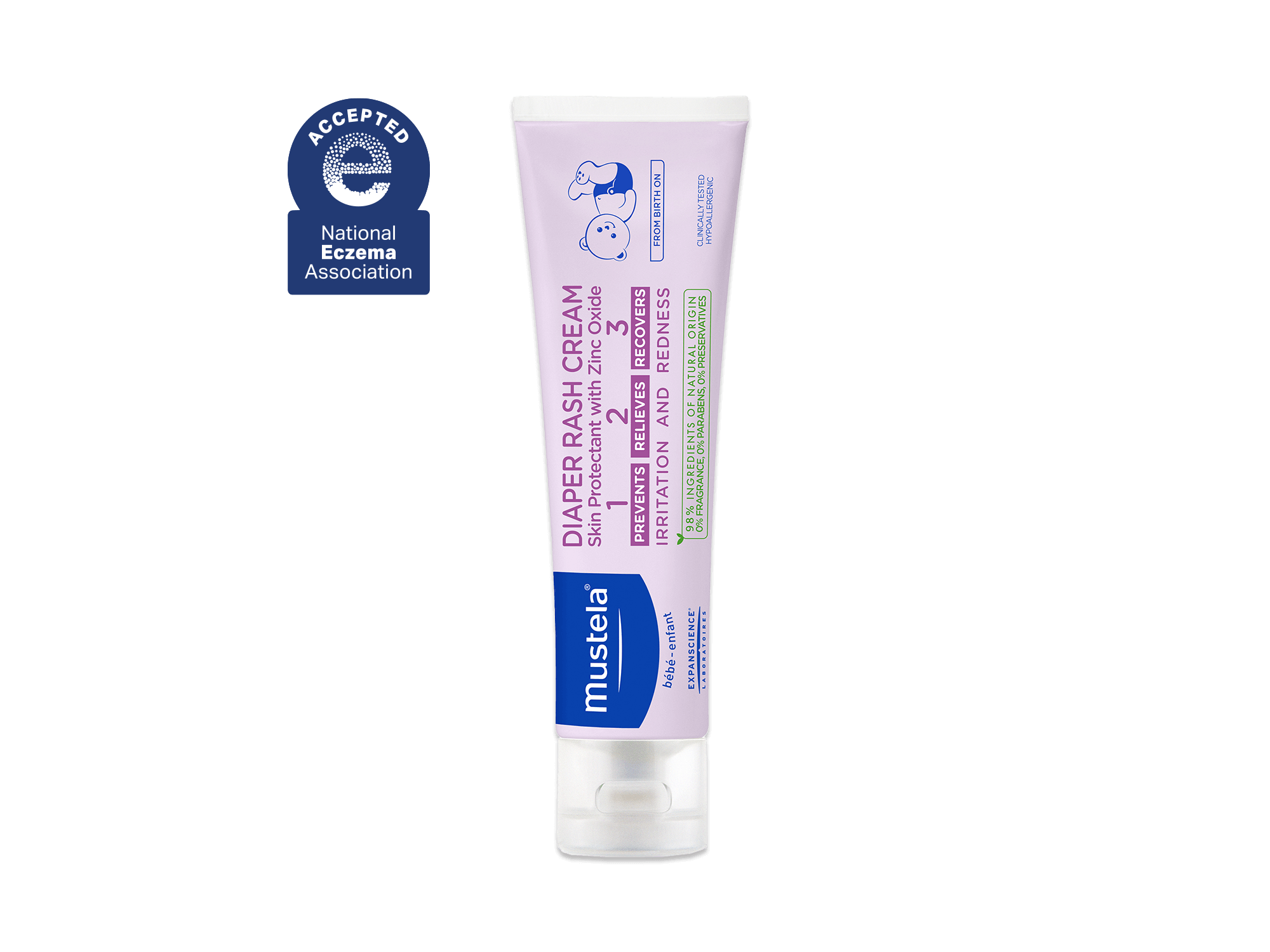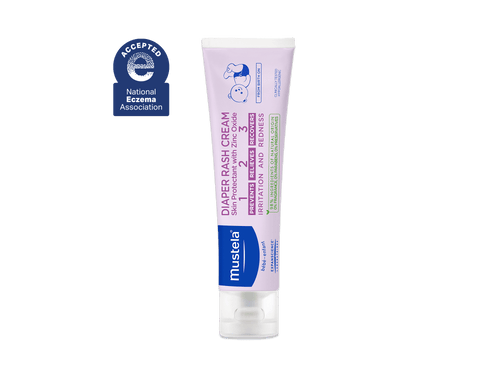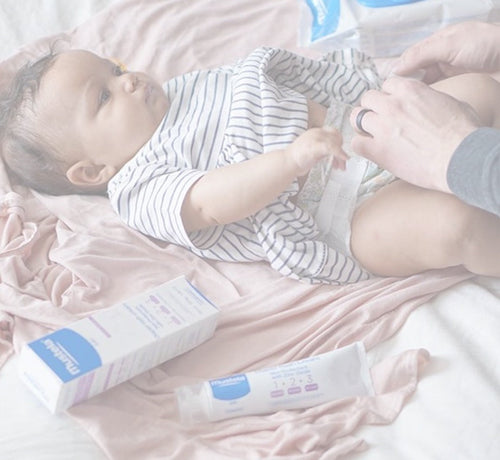When you first notice a rash on your baby’s skin, your thoughts immediately leap to the worst possible causes. But often, the rash you see is just a normal part of being a newborn. So before you begin to panic, let the experts at Mustela calm your nerves and show you the best way to treat your baby’s skin rash.
Table Of Contents
- Identify The Rash
- Keep Your Baby Comfortable
- Treat The Rash
- Consult A Doctor If…
- Frequently Asked Questions
1) Identify The Rash
The first step in treating your baby’s rash is identification. Rashes come in all shapes and sizes, but putting a name to the irritation tells you a lot about how to deal with it.
Here are some of the most common rashes for newborns and infants. After we describe the rashes, we’ll talk more about how to treat them.
Acne
Neonatal acne looks like small red bumps on your baby’s skin. It’s similar to adult acne, but it doesn’t usually progress to the whitehead or blackhead stages. Baby acne can take the form of just one or two bumps over a wide area, or it can present as a large number of bumps in a small area.
Baby acne is thought to be the result of exposure to maternal hormones in the womb (and possibly through breastfeeding). Don’t let that change your breastfeeding habits, though. As you’ll see in the treatment section, baby acne will work itself out.
For a more detailed discussion about baby acne, be sure to check out our article How To Treat & Prevent Baby Acne.
Dry, Flaky Or Peeling Skin
Dry, flaky or peeling skin is very common in newborns and infants. This type of rash looks similar to dry, flaky skin in children and adults.
If your baby’s skin is extra dry, it can become irritated and turn red, swollen, and warm to the touch. Dry skin can manifest during the first year of your baby’s life and any time thereafter, depending on his skin type and environment.
Milia
Milia are small white bumps on your baby’s nose and face that look similar to the whitehead acne that forms on children and adults. Milia are caused by blocked oil glands deep within your baby’s skin.
At first, those bumps may persist despite your best efforts. Don’t worry. As your baby’s oil glands grow and his pores open over the first few days and weeks of his life, the white bumps will be easier to treat.
Cradle Cap
Cradle cap can develop after the first month or two of your baby’s life. It manifests as red, irritated skin with a greasy, yellowish crust on top. While it most often forms on a baby’s scalp (which is why it’s referred to as a “cap”), it can also appear on or spread to his face, neck, armpits, and ears.
Eczema
Eczema looks like red, swollen, itchy patches on your baby’s skin. Depending on his age, it can appear on his chest, legs, knees, arms, elbows, and face. Eczema is caused by a thin, or nonexistent, protective layer (hydrolipidic barrier) on your baby’s skin. This results in dry, sensitive skin that reacts to environmental triggers like dust, scratchy clothing, and pet dander.
Prickly Heat
Prickly heat looks like small red bumps and can be easily confused with baby acne. Prickly heat, though, develops on areas of your baby’s body that are prone to overheating and sweating. Parts of the body like his neck, armpits, and diaper area are prime candidates for prickly heat.
Diaper Rash
Diaper rash is the general term for any skin irritation that develops in your baby’s diaper area. Causes can vary from allergic reactions to skin infections to stress (like during teething), but the most common cause is simply your baby’s sensitive skin not getting enough air.
This is in no way an exhaustive list of skin rashes that can affect your little one. If you have any questions or concerns about a rash that has formed on your baby’s body, always consult a physician. If the rash forms without other symptoms (see last section for details), you can usually treat your baby at home. If the rash persists for more than a week despite treatment, see a doctor. You may need a stronger remedy.
Now let’s turn our attention to the best ways to treat your baby’s skin rash.
2) Keep Your Baby Comfortable

Keeping your baby comfortable is an important step on the road to rash prevention and recovery. Tight, red, swollen, and itchy skin can make your baby (and you) unhappy and make it difficult for him to sleep and feed.
When a rash forms on your baby’s torso (below the neck), it’s a good idea to dress him in loose-fitting clothing (or no clothing at all if the temperature allows it). This will keep the clothing from rubbing the already tender skin, and can keep your baby from getting further overheated.
Another great way to keep your baby comfortable during a rash outbreak is to let him soak or play in the tub. The water will soothe and cool hot, dry skin. You can even help the rash heal by adding a bath product like Mustela’s Stelatopia Bath Oil. These specially-formulated oils soothe and cool tight, swollen skin and make your baby feel good all over.
3) Treat The Rash
Here are some suggestions for treating the most common newborn and infant rashes.

Treating Baby Acne
As your baby’s body processes out, or gets used to, the maternal hormones that can cause acne, his rash will slowly fade away. But this can take weeks, and even months. Keep your baby’s skin clean and healthy using products like those offered by Mustela. We recommend:
These gentle products will keep irritated skin clean without irritating it further.
Treating Dry, Flaky Or Peeling Baby Skin
Dry skin is caused by a lack of moisture in your baby’s skin. The best thing you can do for this type of rash is to apply a hydrating cream with cold cream. We recommend Mustela’s Nourishing Cream with Cold Cream or Nourishing Lotion with Cold Cream. These healing products will keep dry, flaking skin from getting further irritated and infected.
Treating Baby Milia
As your baby’s body becomes accustomed to its new environment outside the womb, his skin will balance and normalize. This will often cause milia to clear up on its own. But you can prevent those white bumps from sticking around longer than they should by keeping your baby’s skin clean.
It would be great if he could spend all day in the bathtub, but that just isn’t possible. Instead, we suggest periodically using Mustela’s No-Rinse Soothing Cleansing Water. The gentle cleanser will soothe and disinfect your baby’s skin to help prevent more milia from forming.
Treating Cradle Cap
For an extensive discussion on cradle cap, see our article The 7 Best Ways To Prevent & Treat Cradle Cap. To treat this common skin condition, shampoo your baby’s scalp two or three times a week with products formulated to treat and prevent cradle cap, like Mustela’s Foam Shampoo For Newborns.
Treating Baby Eczema
The best treatment for baby eczema involves applying an emollient product like Mustela’s Stelatopia Emollient Cream, Stelatopia Emollient Face Cream, or Emollient Balm a few times a day.
Emollients form a protective layer over your baby’s skin to keep triggers from causing a breakout. To prevent skin irritation during bath time, we recommend adding a few drops of Stelatopia Bath Oil to the water.
Treating Prickly Heat
Prickly heat will often clear up on its own if you keep your baby’s skin cool. You can assist the healing process by bathing your child in cool water and patting his skin dry with a soft towel. The itchiness that results from prickly heat will most often be relieved once your baby’s skin cools down.
Treating Diaper Rash
Treatment for diaper rash involves keeping your baby’s skin dry and allowing it to breathe. That may mean going without clothes, or even a diaper, for a while.
You can also help resolve this uncomfortable problem by applying a healing cream to the affected areas. We suggest Mustela’s Liniment or Diaper Rash Cream 1-2-3 to clear up the diaper rash quickly.
If you’re looking for an effective, on-the-go solution for an irritated bum, our Diaper Rash Sprayable Cream does the trick! With over 99% ingredients of natural origin per ISO 16128 standard, this unique formula helps seal out wetness and soothes your little one’s skin.
4) Consult A Doctor If…
The Rash Occurs In Association With Other Symptoms
Such symptoms include:
- Cough
- Fever
- Reduced appetite
- Lethargy
- Sneezing
If you notice a rash erupt on your baby’s body and he exhibits one or more of the above symptoms, it could be a sign that there’s a larger problem at hand. Take your baby to the doctor as soon as possible.

If the rash appears by itself and does not come with any other symptoms, it’s likely just a rash. However, that doesn’t mean that you can disregard it completely. Keep an eye on the rash size, shape, and intensity, and see a doctor if it continues to spread despite treatment.
The Rash Develops Blisters Or Begins To Look Infected
Be on the lookout for any signs of infection including:
- Blisters
- Opaque, yellowish fluid seepage
- Bleeding or dried blood
- Small, bright red or purple dots (petechiae) on top of the rash
These can be an indication of a more serious viral or bacterial infection such as herpes. If any of these symptoms develop on your baby’s body, see a doctor as soon as possible.
Skin rashes on your baby can be scary, but we’ve got you covered. Simply follow the steps listed above to keep your baby happy, healthy, and comfortable.
Frequently Asked Questions
1) What Causes A Rash On A Baby’s Belly?
Irritants, allergies, and infectious diseases can cause a baby’s stomach to break out in a rash. For example, if your little one sits in a soaked diaper for too long, they can experience a diaper rash on their belly.
The red bumpy patches can also occur when your baby’s skin is exposed to a new food or product, such as laundry detergent. If you’ve recently switched brands or scents, it’s important to watch for allergic reactions.
In addition, a common childhood disease, like roseola or chicken pox, could be causing the rash.
2) How Can I Get Rid Of The Rash On My Baby’s Stomach?
Since so many things can cause a rash on your baby's belly, there’s no one-size-fits-all answer to this question. But, in most cases, you can treat a rash at home with some basic self-care measures.
For example, you can use Gentle Cleansing Gel to keep your baby's skin clean without causing any additional irritation. After their bath, apply a baby-friendly moisturizer, such as Hydra Bebe Body Lotion, to lock in moisture.
But if home treatment doesn’t work or the rash starts to spread, it’s essential to see a doctor.
3) Can Teething Cause A Rash On My Baby’s Belly?
When your baby cuts a tooth, they tend to drool a lot more. This can sometimes cause a drool rash around their mouth. But doctors don’t typically blame teething on rashes on other body parts.
If you notice a rash on your baby’s belly and they’re also teething, it’s probably just a coincidence. But if you’re concerned, it’s always best to consult a doctor.
4) When Should I Worry About My Baby’s Stomach Rash?
While many rashes on your baby's body are common, some can signify a more severe condition. This is especially true if the rash is accompanied by other symptoms, such as high fever, diarrhea, or vomiting.
So if you're ever worried about a rash on your baby's stomach, it's always best to consult a doctor. They can help pinpoint the exact cause and recommend treatment options to help keep your little one's skin healthy.



















